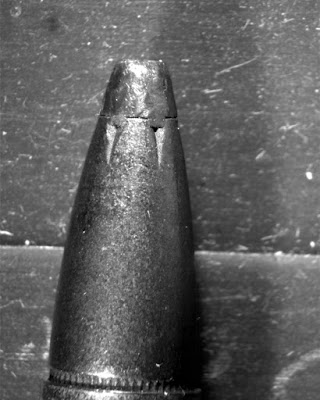I attended a local cartridge show and had a chance to visit
a small but fiercely loyal group of collectors.
It was fun.
Some cartridges have only tiny differences so that the
rounds are interchangeable.
Other examples of different names for the exact same
cartridge include the .244 Rem. and 6mm Rem., .25-20 Win. and .25 WCF, .250
Savage and .250/3000 Savage, .32-20 Win. and .32 WCF, and .44-40 Win. and .44
WCF. Many other cartridges have two or more names.
Others can be interchanged only in one direction. A perfect example is the .38 Special and .357
Magnum. Revolvers sized for .357 magnum
will safely fire both the magnum load and .38spl load. The .38spl revolver cylinder will not close
if it’s loaded with a .357 magnum. Easy –Peasy.
Many rifle cartridges have double names and more than a few
spread confusion with similar names, like the 7mm. In short order we have :
7-30 Water,
7mm Mauser aka 7X57mm,
7mm-08,
.280 Remington 7mm Express Remington,
.280 Ackley Improved,
7mm Remington Magnum,
7 mm Remington Short Action Ultra Mag,
7mm Winchester Short Magnum aka 7mm WSM,
7mm Weatherby Magnum,
7mm Shooting Times Western aka 7mm STW (did you expect
something else?),
7mm Remington Ultra Mag.
And I/n will not diving into the family of military 7mm.
So you can see there is a lot of material to collect and
sort and at a reasonable price. I might
hazard a guess and suggest you might own one of each of those for $150 total if
you shop carefully.
It’s also a lesson that if the rifle says 7mm, it may not be
what you think. So be careful.
I bought a 7mm-08 round mostly because of the bullet. The end of the bullet had little checks that
suggested the round was designed to mushroom on impact. The bullet had a funny look to it. The seller muttered about different bullets
for improved performance, ion hardened and so forth. I just thought it was interesting.
 |
| The seller had me with the little indents at the tip. |
Back at work, I took a photo of the bullet and while examining
the round the bullet just reminded me of something. I took a little piece of paper and rubbed the
bullet on it and was rewarded with a black smear. Lead, perhaps?
Luckily I have analytical equipment that I can use and
quickly determined the smudge was molybdenum disulfide. How about that!
Maybe 20 years ago moly disulfide was the hot ticket. This slippery solid material is used as a dry
lubricant. Somebody reasoned if they
imbedded moly disulfide on the surface of copper or lead bullet it would slip
out of the barrel cleaner and easier.
Cleaner results in less fowling which would give better accuracy longer. (I just shot a box of 69 gr. .223 rem from
Black hills that was treated with moly. Can’t say I noticed better performance
on steel plates.)
Every bullet or cartridge modification seems to be driven by
improved accuracy, followed by improved stopping power. What other reason would you have? Well there are a few, but that’s another
time.
I do remember trying custom loads for 9mm with a moly
coating. It seems, I was told later, the
friction between the bullet and barrel’s lands and grooves helps retain the
bullet in the gun barrel. This time
allows for sufficient combustion of the gun power to build up the required
pressure needed to propel the bullet at expected velocities.
Moly coatings were allowing the bullet to slip out too soon
as demonstrated by lower muzzle velocities.
So that meant more and faster burning gunpowder was required, which
caused more barrel fouling. That
affected accuracy sooner and the whole concept of moly coated bullets was a
wash. I really don’t remember seeing any
for sale now-a-days.
The 7mm-08 in itself is an interesting cartridge. The cartridge is derived from a wildcat
cartridge known as the 7mm/308 popular round 1958.
Wildcatters are funny birds.
They will try all kinds of sizes, combinations and barrels in an attempt
to improve performance and answer the question “What If?” Some may gain some level of fame for the
uniqueness of their round, like the semi-mythical 22-50 BMG, a round comprised
of a .223 diameter bullet on a necked down .50 BMG case.
Others become an accepted by the shooting population and
manufactured by big name companies.
7mm-08 is one of these. The name
doesn’t suggest it was a 7mm modified in 2008, but a .308 Winchester case
necked down to accept 7 mm (.284) bullets.
 |
| Thank you Internet! Here's the 7mm-08 and it's brother .308 win. |
It’s a well-established round with good performance and
through the combination of high ballistic coefficient and velocity produces the
desirable “flat trajectory.” The round
has found favor with metallic silhouette and long range shooters as well as hunters and fun shooters.
Shooters like the reduced recoil and accuracy and find the
slightly reduced range very livable. I
have to agree, I can live very comfortably with a 300 yard rifle instead of a
400 yard rifle. In my neck of the woods,
300 yards is plenty.
It’s reported Jeff Cooper preferred this round in his Scout
Rifle and this round has been found suitable for most North American game (with
the right bullet!) with the exception of the apex predators, polar, brown and
grizzly bears.
I got all this for a little computer time, a couple of books
I already had, and a buck and a half purchase.
It’s a good deal!
Comments
Post a Comment